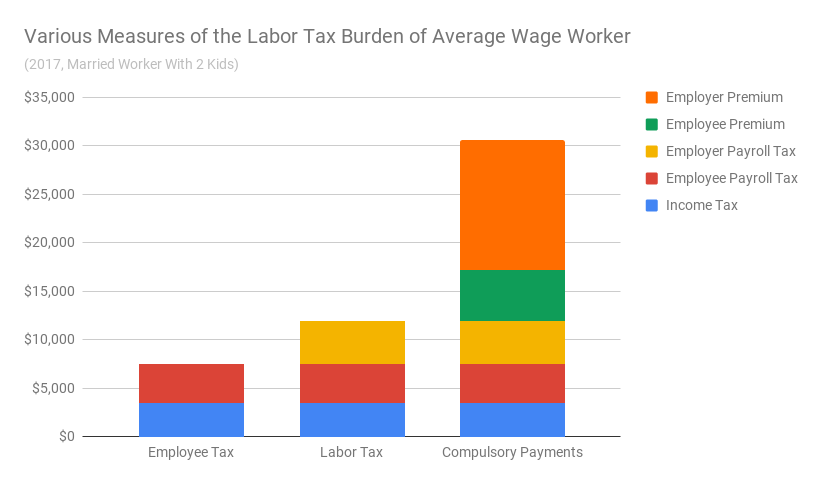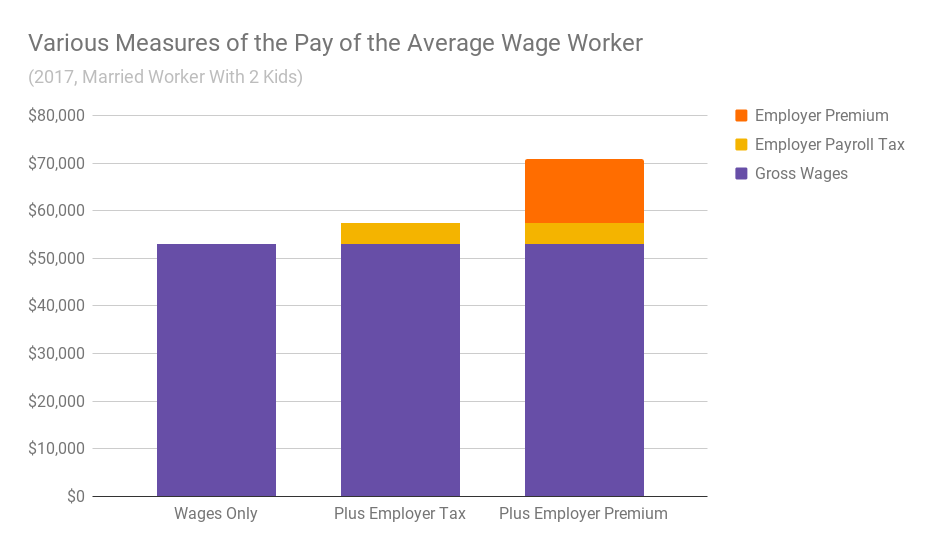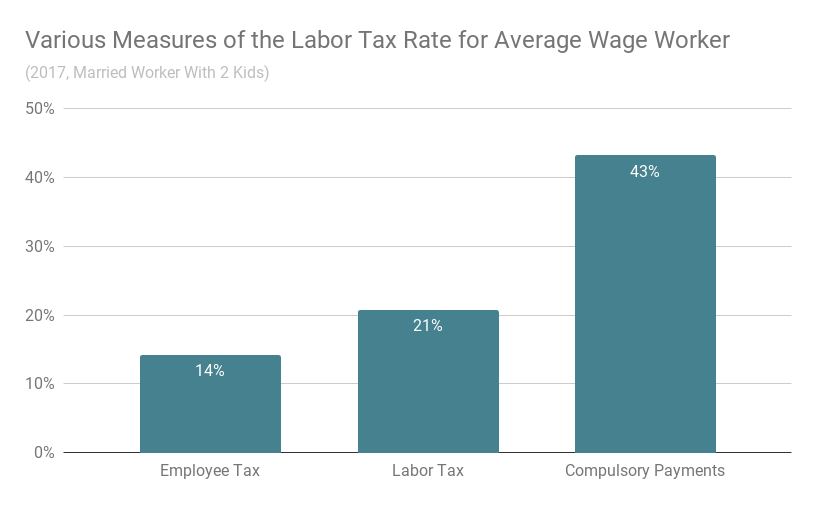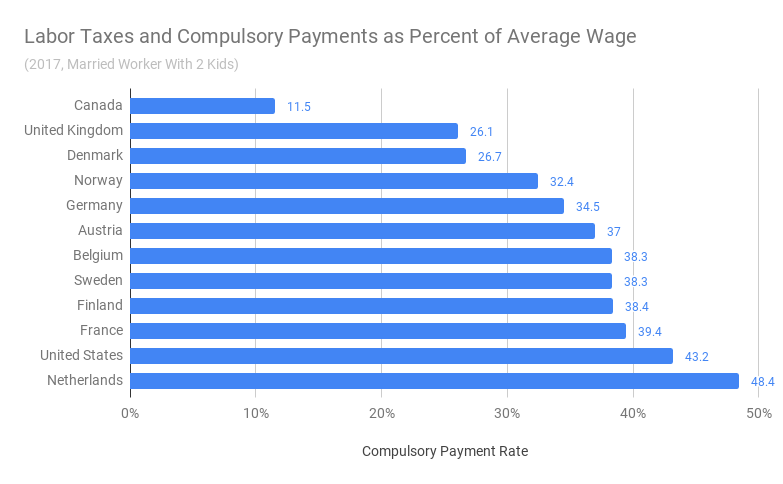
Posted on 04/11/2019 5:59:28 AM PDT by vannrox
Comparing labor tax rates across countries is a tricky endeavor. Some countries rely mostly on income and payroll taxes charged to workers, others on payroll taxes charged to employers, and still others on compelling workers and employers to pay private parties who provide pension and health insurance products. To get an apples-to-apples comparison, you have to normalize all of these various schemes into a single labor tax concept that actually reflects just how much labor compensation is being put towards compulsory payments of one sort or another.
The OECD produces a number of Taxing Wages publications each year that permit this sort of cross-country comparison. Most of these publications focus on converting formal labor taxes into a standardized format that allows researchers to calculate comparable “labor tax wedges” across the various tax schemes.
But formal labor taxes are limited because they omit “non-tax compulsory payments” (NTCPs). NTCPs are payments workers and employers are legally compelled to pay to private parties. NTCPs are no different from taxes except that NTCPs are made to private corporations like health insurance companies rather than to the government.
Occasionally the OECD publishes information that combines formal taxes and NTCPs together in order to allow researchers to compare “compulsory payment rates” across countries. The last time they did this was in 2018. The 2018 OECD publication acknowledges that employer health insurance premiums in the United States are NTCPs because they are mandated under Obamacare’s employer and individual mandates. But the publication nevertheless excludes employer health premiums from its US NTCP calculations because the authors say these premiums cannot be modelled to their satisfaction.
The apparent reason these mandated premiums are incompatible with the OECD’s Taxing Wages model is that they are open-ended payments: employers and employees have to buy private insurance regardless of its cost. If the mandated premiums were set by law as a fixed sum per worker or percentage of payroll as in other countries, then they could be included in the OECD’s figures.
The OECD may not be able to include employer-based health insurance premiums into its model, but I certainly can. And when I add them into the OECD model, I find that the average American worker has one of the highest compulsory payment rates in the developed world.
For this analysis, I take the information from the OECD’s Taxing Wages model and combine it with data from the Medical Expenditure Panel Survey (MEPS). The MEPS data shows the average premium for employer insurance, broken down by type of coverage (family or single) and payer (employer or employee). By counting those average premiums as NTCPs, we can compute a compulsory payment rate that is comparable to the compulsory payment rates the OECD produces for other countries.
To be clear about what I am doing here, the following graph provides a detailed breakdown of the difference between what we normally think of as “employee taxes” and the OECD concept of “compulsory payments.” This graph is for a married wage-earner with two kids who earns the average wage and has a family insurance plan through their employer.

If you are going to count employer-side payroll taxes and employer premium contributions towards the labor tax burden, then you also need to count those things as worker pay. The following graph mirrors the one above except it shows what the average wage really is when you count all of the employer’s labor costs, not just the cash it pays to employees.

Finally, we can divide each labor tax concept by each pay concept to show the difference between what we often think of as the “employee tax rate” and the actual “compulsory payment rate” (share of labor compensation going to tax and NTCPs).

The comprehensive measure shows that a married couple with two kids that makes the average wage pays over 43 percent of their income in compulsory payments of one sort or another. Health premiums are 26.4 of the 43.2 points.
Finally, we can go back to the OECD NTCP data and compare the US to other developed countries. When we do that, we find that only the Netherlands — with its compulsory private health insurance and compulsory private pension — has a higher labor tax burden by this measure.

If you want to know what it is like to pay income taxes like they do in Europe, then looking closely at your paystub would be a good start. We don’t pay as many formal taxes as they do, but when you bring in payments we are compelled to pay and that are deducted straight out of our paychecks just like taxes are, it really does not look that much different, at least as far as labor taxes are concerned.
Ultimately, this is a long exercise in pointing out the obvious: American workers already pay more than enough money to provide good health care to everyone in the country. It’s just that they pay it into a private insurance system that wastes large portions of it on rents and administrative redundancy. As the Mercatus Center noted last year, by implementing a Medicare for All system, the US could insure 30 million more people, provide dental, vision, and hearing coverage to everyone, and virtually eliminate out-of-pocket expenses, all while saving $2 trillion over the first decade of implementation.
Look for the Democrats to pound this point home 24/7/365.
Don’t expect dumb-as-a-brick insurance companies to do anything to defuse it.
Does ANYONE beleive the gummint does ANYTHING cheaper than the private sector? Does anyone beleive Medicare for All will reduce administrative overhead? Really?
Actually, the payments are not compulsory. Only the penalty is. That is all that can be factored in.
Also, the penalty is no longer compulsory. This is why I said last fall that the big news of 2019 will be the collapse of Obamacare because it is the first year it doesn’t have the mandate.
We have a lot of other stuff going on, but just keep watching. It will be a big deal as the number of people going without health care insurance explodes. It probably already has, but nobody is reporting it. Just a guess. :)
And Obamacare was just found to be unconstitutional in a court of law (now that there is no mandate). I wonder if it will stand. I wonder if it means that people that didn’t have insurance in 2018, and yet didn’t pay the penalty, will end up having to pay the penalty.
Auto insurance is manadatory in my state. If my state said we will require that the auto insurance be withheld from wages then this model would include that as a compulsory tax. This model is deeply flawed.
Those who don’t have employer sponsored plans are supposedly paying for health care insurance too. But that doesn’t count.
I do like the fact that it emphasis that the employee must earn all of the taxes that the employer pays as said here:
“The following graph mirrors the one above except it shows what the average wage really is when you count all of the employer’s labor costs, not just the cash it pays to employees.”
Numerous Freepers beleive that they do not earn the employer SS “contribution” they beleive somehow that it is magically given to them. “Labor tax burden” is a great term.
I had to pay it....
I turned 65 last September (2018) and got on board w/ Medicare & a great supplemental insurance that was extremely affordable.. Because I was uninsured ANY part of 2018 the ‘penalty’ was applied.
Before that any form of insurance was WAY too expensive. I would have had to give up driving and some groceries in order to afford it.
I absolutely loathe the political class that burdened us with the greatest of legislative turkey of all time. They are able to enjoy taxpayer funded Cadillac plans in conjunction with the parasite classes of leeches who coast through life.
So - to answer your question.....yes.
One thing I find interesting:
When I paid my taxes last year, I had to pay a penalty for underpaying. It was going to be $50 or so, but they allowed me to check a box allowing them to figure it out, so that’s what I did. I used the 1040EZ, BTW. I paid my taxes and expected a notification regarding what I owed in penalty. I have no doubt I’ll get it, but I haven’t gotten it yet.
I understand that you paid it, but my question is, what if you just checked the box at the top of the 1040 form and went on your merry way?
BTW, in my case, I don’t have to pay the penalty because of the 8% rule. I’m also 65 and the bronze plan would cost more than 9% of my gross income.
More then half my money goes to taxes and the politicians still want more.
I can tell you that the rate listed for Canada is utter nonsense!
Direct deductions off my paycheque are close to 18%, plus what the employer pays (at least half again as much).
Then there are the additional taxes added whenever I buy something. and then there are the hidden taxes on things like gasoline etc.
That 11.8% is a blatant LIE. That makes the entire article wholly unbelievable.
11.8% I WISH!!
Disclaimer: Opinions posted on Free Republic are those of the individual posters and do not necessarily represent the opinion of Free Republic or its management. All materials posted herein are protected by copyright law and the exemption for fair use of copyrighted works.